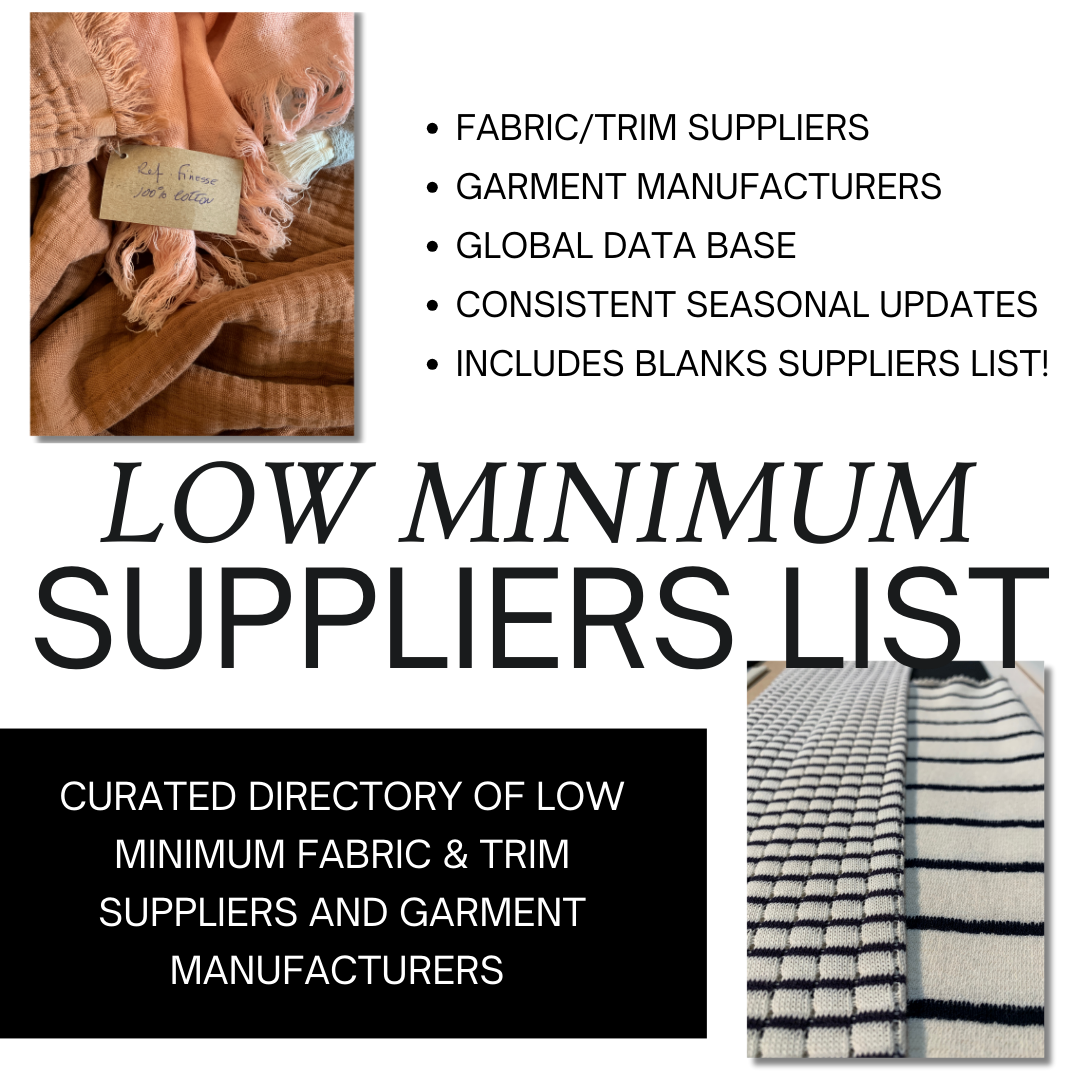Fabric Sourcing for Fashion Brands
“Where can I find a fabric supplier for ::enter any fabric quality::”
“Where can I find a manufacturer that offers low minimum orders?”
These are the MOST ASKED QUESTIONS I get in my Instagram DMs from small brands and start ups.
And, look, you can engage in our services, and we could tell you where all the suppliers that sell any kind of fabric are, have samples sent to you, oversee the fabric development, arrange to have it sent to the clothing manufacturer and send you an invoice for our services. We could do that. This is a service that fashion agencies like ours provide.
Or I can send you to the Directory where you can find the curated list of fabric suppliers across the globe that sell certified fabrics and clothing manufacturers specifically offering low minimums to smaller brands. You will save a ton of time using our Directory because the suppliers have been vetted for their fabric qualities and their minimums.
But truly, no matter where you start sourcing suppliers, you need to be MORE SPECIFIC in what type of fabric you are looking for. You need the fabric in your hands to see if it will really work for your designs.
image copyright Franky Dune
Is the colour right? Is the weight correct? Does it hang, fold, move the way you want it to? Are the darts holding up well? Is the fabric being weighed down by the zipper? All all of the details that make a garment hang, move and SELL well, come down to the fabric.
Let’s have a look a little further into fabric sourcing.
1. DETERMINE YOUR FABRIC REQUIREMENTS
Do you have a clear understanding of the performance and aesthetic qualities the fabric should have for your designs? Define the specific types of fabrics you need for your fashion brand. Factors such as fibre content, fabric weight, is it a woven or a knit, what is the colour, and is there a finish all come into play when sourcing fabric for your designs.
2. RESEARCH AND NOTE POTENTIAL SUPPLIERS
Sustainable fabric? Organic fabric? Recycled fabric? Look for fabric suppliers that align with your brand's values and requirements. You can search online directories, attend trade shows, or find fabric suppliers through online searches. Consider factors like quality, price, minimum order quantities, lead times, and their ability to meet sustainability or ethical standards if those are important to your brand.
3. RESEARCH THEIR REPUTATION: CAREFUL OF GREENWASHING
Before making any order, do your due diligence to ensure the supplier is reputable and reliable. If there are customer reviews, read them. If possible, visit the factory or request additional information about their manufacturing processes and, if applicable, any certifications. If you can’t get to the factory for a visit, consider hiring a third party like an agent to do this for you. Greenwashing is prevalent in every step of the fashion process, from the suppliers to brand’s final marketing. Side step this as best as you can by doing your research.
4. REQUEST FABRIC SAMPLES
This is my favourite part and I can’t emphasise enough the importance of ordering samples before going all in on a fabric. Once you've shortlisted potential suppliers, request fabric samples from each of them so you can properly assess the quality, the weight, the texture, and overall suitability of the fabric for your designs. What looks a certain way online can be all too different in real life. Evaluate the samples, give them a wash test, make notes on their performance, durability, and how well they align with your brand's vision.
Check out this video for the perfect example of colour shock from organic cotton terry fabric dyed with gambier extract that I ordered online.
5. LEARN SUPPLIER’S PRICING AND TERMS
Often you will receive the pricing along with the sample. You will need to know their terms and conditions, clarifying their minimum order quantities, their lead times, their payment and shipping terms.
6. ESTABLISH WORKING RELATIONSHIP
Once you've found your fabric supplier, selected your fabric(s), ordered, received and approved your samples, and placed your bulk fabric order, you are entering a (hopefully!) strong working relationship with them.
7. FUTURE ORDERS & SUPPLIER PERFORMANCE
Maintaining standards in your clothing designs is crucial to your brand’s reputation. Continuously monitor the quality of the fabric for every reorder. If you notice a difference in quality, make sure you communicate this with the supplier to learn why. Maintain an ongoing evaluation process to ensure they continue to meet your brand's requirements and make adjustments if necessary.
Remember, each fashion brand has unique needs and considerations, so tailor the fabric sourcing process to your specific requirements. Building strong relationships with reliable suppliers is crucial for long-term success in the industry.
Hope this helps!
I post often on Instagram from manufacturer showrooms, factory tours and trade shows. Come say hi!





